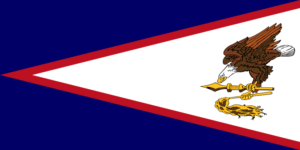The Samoan Islands are believed to have first appeared around 1000 BC. Resolved. They were first discovered by Europeans in 1722 by the Dutchman Jakob Roggeveen. In 1768, the French explorer Rouxhe Antoine de Bougainville visited the islands and named them the Navigator Islands. There was little contact at the time until traders and missionaries began visiting the island in the mid-19th century.
At the end of the 19th century, there was a dispute between Germany and the United States over this island. The islands were divided into two countries. The American side would be the territory of the United States, now American Samoa.
American Samoa enjoys a degree of autonomy as a territory of the United States. People born in American Samoa are not considered U.S. citizens and cannot vote in elections, but can travel freely to and from the rest of the United States.
| Capital | Pago Pago |
| Population | 43,850 (Source: 2023 worldometer) |
| Major Cities | Pago Pago (capital), Tāfuna, Leone, Faleniu, Matavai, Salelologa |
| Borders | East of the International Date Line and Wallis and Futuna Islands, west of the Cook Islands, north of Tonga, and some 500 kilometers (310 mi) south of Tokelau |
| Gross Domestic Product (GDP) | $660,670,229 (2022 worldometer) |
| Currency | US dollar (USD) |

American Samoa Major Industries: tuna canneries (largely supplied by foreign fishing vessels), handicrafts
American Samoa Agricultural Products: bananas, coconuts, vegetables, taro, breadfruit, yams, copra, pineapples, papayas; dairy products, livestock
American Samoa Natural Resources: pumice, pumicite
American Samoa Major Exports: canned tuna 93% (2004 est.)
American Samoa Major Imports: materials for canneries 56%, food 8%, petroleum products 7%, machinery and parts 6% (2004 est.)
Total Size of American Samoa: 199 km2 (source: 2022 wikipedia)
Geographical Low Point of American Samoa: Pacific Ocean 0 m
Geographical High Point of American Samoa: Lata Mountain 964 m
Climate of American Samoa: Tropical marine, moderated by southeast trade winds; annual rainfall averages about 3 m; rainy season (November to April), dry season (May to October); little seasonal temperature variation
General Terrain of American Samoa: five volcanic islands with rugged peaks and limited coastal plains, two coral atolls (Rose Island, Swains Island)
World Region or Continent of American Samoa: Oceania
Geographical Coordinates: 14 20 S, 170 00 W
American Samoa Government Type: NA
American Samoa Nationality: American Samoan(s) (US nationals)
American Samoa National Holiday: Flag Day, 17 April (1900)
American Samoa Independence: none (territory of the US)
American Samoa National Symbol:
American Samoa National Anthem or Song: Amerika Samoa (American Samoa)
American Samoa Languages Spoken: Samoan 90.6% (closely related to Hawaiian and other Polynesian languages), English 2.9%, Tongan 2.4%, other Pacific islander 2.1%, other 2%
American Samoa Religions: Christian Congregationalist 50%, Roman Catholic 20%, Protestant and other 30%
American Samoa is considered an unincorporated, unorganized territory of the United States. Essentially, this means American Samoa enjoys the diplomatic and military protection of the United States, although not all provisions and protections of the United States Constitution apply.
Tutuila Island in American Samoa has the highest concentration of fast food restaurants and is the largest consumer of fast food in the entire South Pacific.
American Samoan airline Samoa Airlines introduced a weight-based payment system to its passengers in 2013. In this system, passengers have to stand with their luggage on a scale, and the resulting personal weight determines the fare they have to pay.
In 1966, the United Nations offered American Samoa the option of merging with the Independent State of Samoa as an independent state, but the majority of the population voted to remain an American territory.
In the 1960s, the United States invested heavily in building schools, roads, housing, a hospital, and two tuna factories to improve living conditions in American Samoa.
Junior Sew was one of the most famous Samoan Americans to ever play in the NFL.
American Samoa has been nicknamed “Football Island” because it produces more American football players than anywhere else in the world. Young people from American Samoa are 56 times more likely to play in the NFL than American young people. Currently, 30 players in the NFL are American Samoans, and over 200 American Samoans play NCAA division football.
The tuna cannery employs approximately 80% of American Samoa’s workforce. A tuna cannery worker makes an average of about $4,300 a year. The remaining 20% of him work in the US government or agriculture.
About 93% of American Samoa’s exports are canned tuna, with 100% of exports going to the United States.
American Samoa consists of five volcanic islands (Tutuila, Aunuu, Manu’a Ofu, Olosega and Tau) and two coral atolls (Rose Atoll and Swains Atoll).
The total territory of American Samoa is 117,500 square miles (30,400 square kilometers), which is roughly the size of Oregon or New Zealand. However, only 76.1 square miles (197 square kilometers) of her territory, or 0.1% of her territory, is actually on the mainland.
Her 2015 population of American Samoa was her 54,343. On Tutuila alone, 48,000 people live in the capital Pago Pago, about 88% of the total population.
Citizens of American Samoa, an unincorporated U.S. territory, are considered U.S. citizens and not U.S. citizens. Most Americans are citizens of American Samoa.
The American Samoa National Park was established by Congress in 1988, but was not officially leased to the National Park Service until 1993, when village chiefs signed a 50-year lease and the Park Service established tropical islands in the islands. You can now manage rainforests, beaches and reefs. Tutuila, Tau, Ofu and Olosega islands.
Going to an empty beach at sunset means really enjoying solitude. – Jeanne Moreau
About half of the people living in American Samoa were born in American Samoa and most immigrants come from the Independent State of Samoa. About 128,000 people of American Samoan descent live outside American Samoa, mostly in the mainland United States.

